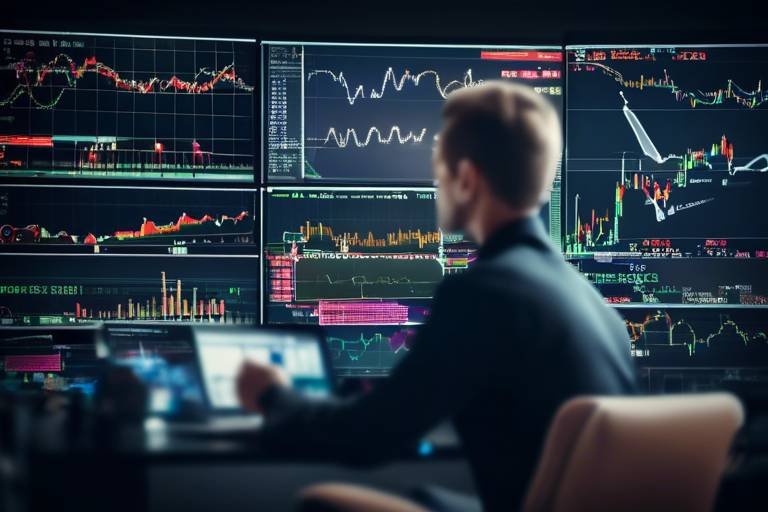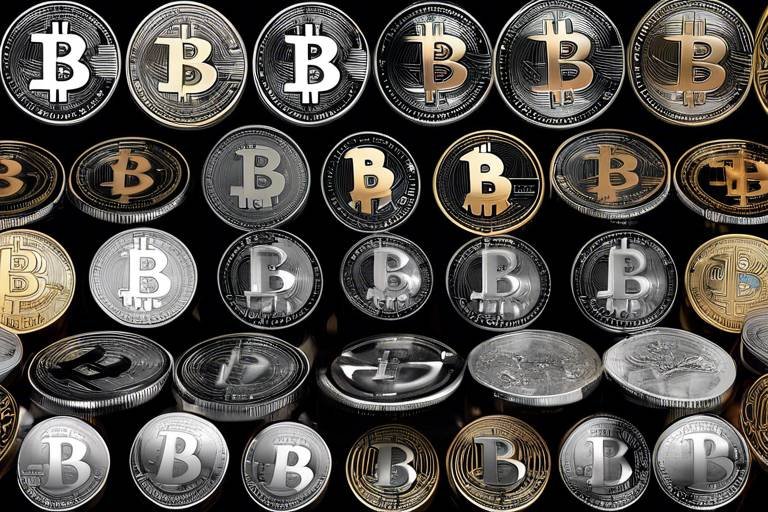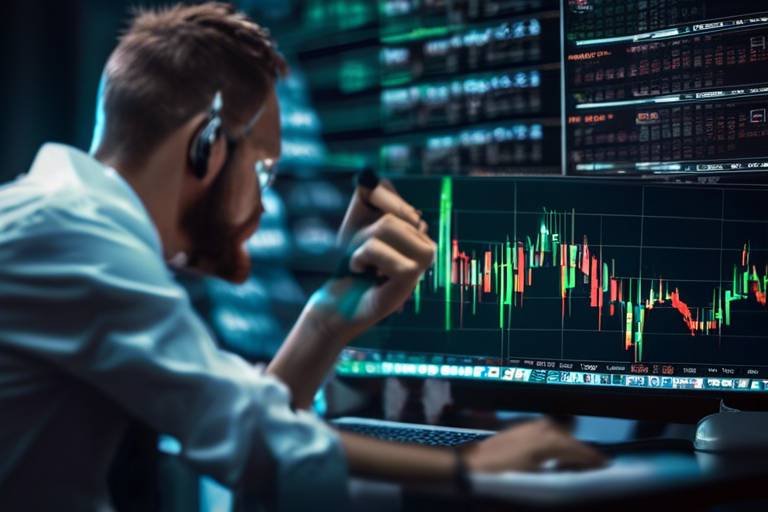How to Analyze Cryptocurrency Exchanges for Trading
When it comes to trading cryptocurrencies, choosing the right exchange can be a game changer. With the vast number of platforms available, it can feel overwhelming to sift through the options. This article explores essential factors to consider when analyzing cryptocurrency exchanges, offering insights into their features, security, fees, and more to help traders make informed decisions. Think of it like picking the right tool for a job; the right exchange can make your trading experience smoother and more profitable.
Different types of cryptocurrency exchanges exist, including centralized, decentralized, and hybrid platforms. Each type has unique characteristics, benefits, and drawbacks that traders should understand before choosing where to trade. Centralized exchanges, like Binance and Coinbase, act as intermediaries, making them user-friendly but potentially vulnerable to hacks. On the other hand, decentralized exchanges (DEXs) like Uniswap allow for peer-to-peer trading without a middleman, offering greater privacy but often less liquidity. Hybrid exchanges aim to combine the best of both worlds but can be tricky to navigate. Understanding these differences is crucial in making an informed decision about where to invest your time and money.
Security is paramount in cryptocurrency trading. With the rise of cyber threats, it's essential to evaluate the various security measures exchanges implement. Look for features like two-factor authentication (2FA), which adds an extra layer of protection by requiring a second form of verification. Cold storage is another critical aspect, as it involves keeping the majority of funds offline, away from potential hackers. Additionally, some exchanges offer insurance policies to protect users' assets in case of a breach. Always do your research on an exchange's security protocols before committing your funds.
Trading fees can significantly impact your profitability, so it's important to analyze the fee structures of different exchanges. Most platforms operate on a maker-taker model, where the maker provides liquidity and the taker removes it. Additionally, you might encounter various withdrawal fees that can eat into your profits. To get the best value, compare the fee structures across exchanges. A small difference in fees can lead to substantial savings over time, especially for high-frequency traders.
Liquidity is essential for executing trades efficiently. If an exchange has low liquidity, you may face significant price slippage when trying to enter or exit a position. To assess an exchange's liquidity, look at its trading volume, which indicates how much of a particular asset is being traded over a specific period. Higher trading volumes typically mean better liquidity, allowing for smoother transactions. Always check the trading volume of an exchange before making a decision; it’s like ensuring you have enough gas in your car before a long drive!
A user-friendly interface can enhance trading efficiency significantly. When evaluating exchanges, consider the design and navigation of their platforms. A cluttered interface can lead to mistakes, especially in high-pressure trading situations. Look for features that enhance the user experience, such as customizable dashboards, advanced charting tools, and mobile apps. These tools can help you make informed decisions quickly, ensuring you don’t miss out on lucrative opportunities.
Not all exchanges offer the same range of cryptocurrencies. It’s essential to evaluate the variety of coins available on an exchange to ensure you can access the assets you wish to trade. Some exchanges focus on popular coins like Bitcoin and Ethereum, while others offer a wider selection of altcoins. If you have specific cryptocurrencies in mind, verify their availability on the platform before signing up. It’s like going to a grocery store; if they don’t have what you need, you’ll have to go somewhere else!
Reliable customer support can be a lifesaver during trading issues. When analyzing exchanges, check the types of customer support services offered, such as live chat, email, and response times. A responsive support team can help you resolve issues quickly, which is crucial when every second counts in trading. Look for exchanges that provide comprehensive support, including FAQs and tutorials, to help you navigate their platform effectively.
The reputation of an exchange can greatly influence its reliability. Research user reviews, ratings, and the history of exchanges to ensure a trustworthy trading environment. Platforms like Trustpilot and Reddit can provide valuable insights from real users. A well-regarded exchange with positive reviews is more likely to offer a secure and efficient trading experience. Remember, a good reputation is like a solid foundation; it supports everything else.
- What is the best type of exchange for beginners? Centralized exchanges are often the most user-friendly for beginners.
- How can I ensure my funds are safe? Look for exchanges with robust security measures like 2FA and cold storage.
- What should I do if I encounter issues with an exchange? Contact their customer support for assistance and check their help resources.

Understanding Exchange Types
When diving into the world of cryptocurrency trading, one of the first things you’ll encounter is the variety of exchange types available. It's essential to understand these different platforms, as each offers unique features, advantages, and disadvantages that can significantly impact your trading experience. Think of it as choosing a vehicle for a road trip; the type of car you select will determine your comfort, speed, and the terrain you can navigate.
There are three primary types of cryptocurrency exchanges: centralized exchanges, decentralized exchanges, and hybrid exchanges. Let’s break these down to see what each has to offer.
- Centralized Exchanges (CEX):
Centralized exchanges are the most common and user-friendly platforms. They act as intermediaries between buyers and sellers, meaning they hold your funds and execute trades on your behalf. Examples include Binance and Coinbase. While they offer high liquidity and a wide range of cryptocurrencies, they are also more susceptible to hacks and security breaches. Think of them like a bank: convenient, but you’re putting your trust in someone else to safeguard your assets.
- Decentralized Exchanges (DEX):
On the flip side, decentralized exchanges operate without a central authority. They allow users to trade directly with one another using smart contracts, which means you maintain control over your funds at all times. Platforms like Uniswap and SushiSwap exemplify this model. However, while they offer enhanced security and privacy, they may lack the liquidity and user-friendly features of their centralized counterparts. Imagine riding a bike on a rugged trail; it’s exhilarating and empowering, but you need to be prepared for bumps along the way.
- Hybrid Exchanges:
Hybrid exchanges aim to combine the best of both worlds, offering the security of decentralized trading with the convenience of centralized platforms. They provide a middle ground, allowing users to trade directly while benefiting from the liquidity and user interface of centralized exchanges. While still relatively new, hybrid exchanges are gaining traction as traders seek more balanced options. Picture it as a versatile vehicle that can handle both city streets and off-road adventures.
Understanding these exchange types is crucial for making informed trading decisions. Each type serves a different purpose, and your choice will depend on your trading style, risk tolerance, and the specific cryptocurrencies you wish to trade. Whether you prefer the convenience of a centralized exchange, the autonomy of a decentralized platform, or the balanced approach of a hybrid exchange, knowing these differences can help you navigate the crypto landscape more effectively.

Evaluating Security Measures
When it comes to trading cryptocurrency, one of the most crucial aspects that can't be overlooked is security. The digital nature of cryptocurrencies makes them susceptible to various threats, from hacking attempts to phishing scams. Therefore, understanding the security measures that exchanges implement is essential for protecting your hard-earned assets. Let's dive into some of the key security features you should look for when evaluating an exchange.
First and foremost, many reputable exchanges offer two-factor authentication (2FA). This extra layer of security requires users to provide two forms of identification before accessing their accounts. Think of it as having a double lock on your front door; even if someone manages to get your password, they still need that second piece of information to get in. Common methods for 2FA include SMS codes or authentication apps, which generate temporary codes that are time-sensitive.
Another critical security measure is the use of cold storage. Unlike hot wallets, which are connected to the internet and more vulnerable to attacks, cold storage keeps the majority of an exchange's funds offline. This means that even if a hacker breaches the exchange's online systems, they won't be able to access the bulk of the assets stored in cold wallets. It’s akin to keeping your valuables in a safe at home rather than leaving them on your kitchen counter.
Additionally, some exchanges offer insurance policies to protect users against potential losses due to breaches or hacking incidents. While this doesn't eliminate the risk, it provides an added layer of reassurance. Before signing up, it's wise to check if the exchange has any insurance coverage and what it entails. This can be a deciding factor, especially for traders dealing with large sums of money.
Moreover, it's essential to consider how exchanges handle withdrawal requests. A reliable exchange will have measures in place to verify the identity of users before processing withdrawals. This could include email confirmations or additional security questions. If an exchange has a history of slow withdrawal times or questionable practices, it might be a red flag.
Lastly, never underestimate the importance of transparency. A trustworthy exchange will openly share information about its security protocols, including audits and compliance with regulations. Look for exchanges that provide detailed reports on their security practices and any incidents they've faced in the past. This level of transparency can significantly influence your decision when choosing where to trade.
In summary, evaluating security measures is not just about ticking boxes; it's about ensuring that your trading experience is as safe as possible. By paying attention to features like two-factor authentication, cold storage, insurance policies, withdrawal processes, and transparency, you can make a more informed choice when selecting a cryptocurrency exchange.
- What is two-factor authentication? Two-factor authentication (2FA) is a security process that requires two different forms of identification to access an account.
- Why is cold storage important? Cold storage keeps the majority of an exchange's funds offline, making them less vulnerable to hacking.
- Do all exchanges offer insurance? Not all exchanges provide insurance, so it's crucial to check their policies before trading.
- How can I verify an exchange's security measures? Look for transparency in their security protocols, user reviews, and any published audits.

Analyzing Trading Fees
When it comes to trading cryptocurrencies, understanding trading fees is crucial. These fees can significantly impact your profitability, and overlooking them could lead to unexpected losses. Imagine you're at a market, ready to buy your favorite fruit, but the vendor suddenly adds a hidden charge. Frustrating, right? The same principle applies in the world of crypto trading. Let's dive into the different types of fees you might encounter and how to navigate them effectively.
First, it's important to recognize that exchanges often employ various fee structures. The most common types include maker-taker fees, withdrawal fees, and deposit fees. Maker-taker fees are charged based on whether you add liquidity to the market (maker) or take liquidity away (taker). This can create a complex web of costs depending on your trading style. For instance, if you frequently place limit orders, you might benefit from lower maker fees. On the other hand, if you prefer to execute trades quickly, you may incur higher taker fees. Understanding your trading habits can help you choose an exchange that minimizes these costs.
Next up, withdrawal fees can catch many traders off guard. These fees are charged when you move your cryptocurrencies off the exchange, and they can vary significantly from one platform to another. For example, some exchanges might charge a flat fee, while others calculate fees based on the amount withdrawn. It's wise to check the withdrawal fees before committing to an exchange, especially if you plan to move your assets frequently. To illustrate this, consider the following table comparing withdrawal fees across popular exchanges:
| Exchange | Bitcoin Withdrawal Fee | Ethereum Withdrawal Fee |
|---|---|---|
| Exchange A | 0.0005 BTC | 0.01 ETH |
| Exchange B | 0.0007 BTC | 0.005 ETH |
| Exchange C | 0.0003 BTC | 0.008 ETH |
Additionally, some exchanges may impose deposit fees, although these are less common. If you’re planning to deposit a large sum, even a small percentage fee can add up quickly. Always read the fine print regarding deposits and withdrawals to avoid surprises.
Now, how do you compare these fees across different exchanges? A good approach is to create a spreadsheet where you can track the various fees for the platforms you're considering. This way, you can see at a glance which exchange offers the best value based on your trading habits. Remember, the goal is to find a balance between low fees and the features you need for effective trading.
Lastly, it’s essential to stay informed about any changes in fee structures. Exchanges often update their fee schedules, which can impact your trading strategy. Subscribing to newsletters or following exchanges on social media can keep you updated on any changes that might affect your trading costs.
In conclusion, analyzing trading fees is a vital step in your cryptocurrency trading journey. By understanding the different types of fees and actively comparing them across exchanges, you can make informed decisions that enhance your trading experience and profitability. Don't let hidden fees sneak up on you—stay vigilant and always be aware of the costs associated with your trades!
1. What are trading fees?
Trading fees are charges imposed by cryptocurrency exchanges for executing trades, withdrawing funds, or depositing assets. They can vary significantly between platforms.
2. How can I minimize trading fees?
To minimize trading fees, consider using exchanges with lower fee structures, choosing the right order types (maker vs. taker), and consolidating withdrawals to reduce costs.
3. Are withdrawal fees the same for all cryptocurrencies?
No, withdrawal fees can differ based on the cryptocurrency being withdrawn. It's important to check the specific fees for each asset on the exchange.
4. How often do exchanges change their fee structures?
Exchanges can change their fee structures at any time, so it's crucial to stay informed by regularly checking their websites or subscribing to updates.

Liquidity and Trading Volume
When it comes to trading cryptocurrencies, liquidity and trading volume are two critical factors that can make or break your trading experience. Imagine you're at a bustling market where everyone is buying and selling goods. The more people there are, the easier it is to find someone willing to trade with you, right? That's essentially how liquidity works in the world of cryptocurrency exchanges. High liquidity means that there are plenty of buyers and sellers, allowing you to execute trades quickly and at favorable prices.
On the flip side, low liquidity can lead to what traders dread the most: price slippage. This occurs when the price at which you execute your trade differs from the expected price, often due to a lack of available orders at your desired price point. For instance, if you're trying to sell a cryptocurrency that only a handful of people are interested in, you might have to accept a lower price than you anticipated because there aren't enough buyers. This is why assessing liquidity on an exchange is essential before diving in.
But how do you evaluate liquidity and trading volume effectively? One way is to look at the exchange's 24-hour trading volume. This metric gives you a snapshot of how much of a particular cryptocurrency is being traded over a day. Generally, higher trading volumes indicate better liquidity. You can usually find this information on the exchange's homepage or under the specific trading pair you're interested in. Here's a quick reference table to help you understand how trading volume can impact your trading:
| Trading Volume | Liquidity Level | Potential Impact on Trades |
|---|---|---|
| High (e.g., >$1 million) | High | Quick execution, minimal slippage |
| Medium (e.g., $100,000 - $1 million) | Moderate | Reasonable execution, some slippage possible |
| Low (e.g., <$100,000) | Low | Slow execution, high slippage risk |
In addition to trading volume, consider the depth of the order book. A deeper order book means that there are more buy and sell orders at various price levels, which can help you execute larger trades without significantly affecting the market price. You can visualize this by thinking of a swimming pool. A shallow pool (low order book depth) makes it easy to see the bottom, but if you dive in (make a large trade), you might disturb the water and create waves (price fluctuations). Conversely, a deep pool (high order book depth) allows you to dive in without causing much disturbance.
Moreover, it’s beneficial to monitor the exchange’s historical liquidity trends. Some exchanges may have fluctuating liquidity based on the time of day or market conditions. For example, during major market events or announcements, trading volume can spike, leading to increased liquidity. Conversely, during off-peak hours, liquidity might dwindle. Keeping an eye on these trends can help you strategize your trading times effectively.
In summary, understanding liquidity and trading volume is crucial for any trader looking to navigate the crypto landscape successfully. By choosing exchanges with high trading volumes and deep order books, you can minimize risks and enhance your trading experience. Remember, in the world of cryptocurrency, being able to enter and exit trades swiftly can often be the difference between profit and loss.
- What is liquidity in cryptocurrency trading?
Liquidity refers to how easily an asset can be bought or sold in the market without affecting its price. - How can I check the trading volume of a cryptocurrency?
You can typically find the 24-hour trading volume on the exchange's homepage or the specific trading pair page. - Why is high liquidity important?
High liquidity allows for quicker trade execution and reduces the risk of price slippage. - What is price slippage?
Price slippage occurs when the price at which a trade is executed differs from the expected price due to a lack of liquidity.

User Experience and Interface
When it comes to trading cryptocurrencies, the user experience (UX) and interface of an exchange can make a world of difference. Imagine stepping into a store where everything is organized, easy to find, and the staff is ready to help. Now, picture the opposite: a cluttered space where you can't find what you need and no one is around to assist you. Which store would you prefer? The same principle applies to cryptocurrency exchanges. A well-designed interface not only enhances your trading efficiency but also makes the entire experience more enjoyable.
One of the first things to consider is the design layout. A clean, intuitive design allows traders to navigate effortlessly between different sections, whether they're looking to buy, sell, or analyze market trends. For instance, a good exchange will have clearly labeled tabs for trading pairs, market data, and account settings, ensuring that you can access everything with just a few clicks. Additionally, many platforms now offer customizable dashboards, allowing users to tailor their experience according to their preferences. This personalization can be crucial for seasoned traders who rely on specific data points to make informed decisions.
Another critical aspect is the availability of trading tools. The best exchanges provide a suite of tools that can help traders analyze market conditions, such as advanced charting software, technical indicators, and real-time data feeds. For example, if you're a trader who loves to dive deep into technical analysis, having access to tools that allow for complex chart patterns and indicators is essential. A lack of these features can hinder your ability to make timely and informed trading decisions.
Moreover, let's not forget about mobile accessibility. In today's fast-paced world, being able to trade on the go is a huge advantage. Many exchanges offer mobile apps that mirror their desktop platforms, allowing you to manage your portfolio and execute trades from anywhere. A seamless mobile experience is vital for those who prefer to trade during their commute or while managing other responsibilities. So, before you commit to an exchange, check out its mobile app and see if it meets your expectations.
To further illustrate the importance of user experience, consider this: a recent survey revealed that over 70% of traders prioritize a user-friendly interface when selecting an exchange. This statistic highlights how critical it is for exchanges to focus on UX if they want to attract and retain customers. In fact, many traders will choose a platform that is easier to use over one that offers lower fees or more features simply because their trading experience is less stressful.
In conclusion, when analyzing cryptocurrency exchanges, never underestimate the impact of user experience and interface. A well-designed platform can significantly enhance your trading journey, making it more efficient and enjoyable. Always take the time to explore the interface, test the tools, and assess the overall design before diving into trading. After all, a smooth user experience is like a reliable compass guiding you through the often-turbulent waters of cryptocurrency trading.
- What should I look for in a cryptocurrency exchange's user interface? Look for a clean design, easy navigation, and customizable features that suit your trading style.
- Are mobile apps important for trading? Yes, mobile apps provide the flexibility to trade on the go, which is essential for many traders today.
- How can I assess the user experience of an exchange? Spend some time navigating the platform, checking the availability of tools, and reading reviews from other users.

Available Cryptocurrencies
When it comes to trading on cryptocurrency exchanges, one of the most critical factors to consider is the variety of cryptocurrencies available. Not all exchanges are created equal; some may offer a vast selection of coins, while others might focus on just a handful. This diversity can significantly impact your trading strategy and potential profits. Imagine walking into a grocery store that only sells apples; while they might be the best apples in town, if you're craving oranges or bananas, you're out of luck. Similarly, if your chosen exchange only supports a limited range of cryptocurrencies, you might miss out on lucrative trading opportunities.
To make an informed decision, it's essential to evaluate which cryptocurrencies an exchange supports. Some exchanges focus on major coins like Bitcoin and Ethereum, while others may offer a plethora of altcoins, including lesser-known tokens that could have the potential for substantial growth. Consider the following when assessing an exchange's cryptocurrency offerings:
- Market Cap: Look for exchanges that list coins with high market caps, as these are generally more stable and liquid.
- Emerging Coins: Some traders prefer platforms that support new and emerging coins, which can provide opportunities for early investments.
- Stablecoins: Including stablecoins in your trading options can help you manage volatility and protect your profits.
Moreover, the availability of trading pairs is another crucial aspect. An exchange might offer a wide range of cryptocurrencies, but if it lacks diverse trading pairs, your options for trading could be limited. For instance, if you only have the ability to trade Bitcoin against USD, you might miss out on opportunities to trade Bitcoin against other cryptocurrencies like Ethereum or Litecoin. Therefore, ensure that the exchange provides a variety of trading pairs to facilitate your trading needs.
To illustrate this point, here’s a small comparison of three popular exchanges and the number of cryptocurrencies they offer:
| Exchange | Number of Cryptocurrencies | Notable Coins |
|---|---|---|
| Exchange A | 150+ | Bitcoin, Ethereum, Cardano |
| Exchange B | 50+ | Bitcoin, Litecoin, Ripple |
| Exchange C | 200+ | Bitcoin, Ethereum, Chainlink, Polkadot |
As you can see, Exchange C offers the most extensive selection, which could be a significant advantage for traders looking to diversify their portfolios. However, it's essential to balance the number of available cryptocurrencies with other factors like security, fees, and user experience.
In conclusion, the variety of available cryptocurrencies on an exchange can greatly influence your trading experience and success. Always do your homework and ensure that the exchange you choose aligns with your trading goals and preferences. After all, in the ever-evolving world of cryptocurrencies, having access to the right tools and options can make all the difference in your trading journey.
Q: Why is the variety of cryptocurrencies important for trading?
A: A diverse selection allows traders to explore various investment opportunities, hedge against market volatility, and take advantage of emerging trends.
Q: How can I find out which cryptocurrencies an exchange supports?
A: Most exchanges provide a list of supported cryptocurrencies on their websites. You can also check their trading pairs to see how you can trade different coins.
Q: Are lesser-known cryptocurrencies worth trading?
A: While they can be riskier, lesser-known cryptocurrencies may offer significant growth potential. Always conduct thorough research before investing.

Customer Support Services
When diving into the world of cryptocurrency trading, one often overlooks the significance of offered by exchanges. Imagine you're in the middle of a trade, and suddenly you encounter a technical glitch or have a burning question about your account. In such moments, having access to reliable and responsive customer support can be the difference between a successful trade and a missed opportunity.
Different exchanges offer various support options, and understanding these can save you a lot of headaches down the line. For instance, some platforms provide 24/7 live chat support, allowing you to get immediate assistance. Others might rely solely on email support, which can lead to frustrating delays. Additionally, the quality of customer support can vary significantly; some exchanges are known for their quick response times, while others may leave you hanging for hours, if not days.
Here are some key aspects to consider when evaluating customer support services:
- Availability: Check if the support team is available around the clock or only during specific hours. This can be crucial for traders in different time zones.
- Multiple Channels: Look for exchanges that offer various channels for support, such as live chat, email, and phone support. The more options, the better!
- Response Time: Research how quickly the support team responds to inquiries. A quick turnaround can alleviate stress during urgent situations.
- Quality of Support: Read user reviews to gauge the quality of support. Are the agents knowledgeable? Do they resolve issues effectively?
To give you a clearer picture, here's a comparison table of customer support services from a few popular exchanges:
| Exchange | Support Channels | Response Time | Availability |
|---|---|---|---|
| Exchange A | Live Chat, Email, Phone | Under 1 hour | 24/7 |
| Exchange B | Email, Live Chat | 1-3 hours | 9 AM - 9 PM |
| Exchange C | Live Chat | Under 30 minutes | 24/7 |
In conclusion, while the allure of trading cryptocurrencies can be exciting, it's crucial to not underestimate the importance of customer support services. A robust support system can enhance your trading experience, providing peace of mind as you navigate the often volatile market. So, before you choose an exchange, take a moment to evaluate their customer support options. After all, having a reliable safety net can make all the difference in your trading journey.
Here are some common questions traders have regarding customer support services:
- What should I do if I encounter an issue during trading? It's best to reach out to the customer support team immediately through the available channels.
- How can I find out the response time for customer inquiries? You can usually find this information on the exchange's website or by checking user reviews.
- Is 24/7 support necessary for trading? While not essential, 24/7 support can be very beneficial, especially for traders in different time zones.

Reputation and Reviews
When it comes to trading on cryptocurrency exchanges, the reputation of the platform can make or break your trading experience. Imagine you're about to jump into a pool; wouldn't you want to know if the water is safe and clean before diving in? Similarly, understanding an exchange's reputation is crucial in ensuring that your hard-earned money is in safe hands. A reputable exchange not only builds trust but also offers a sense of security that can ease the anxiety of trading in such a volatile market.
To gauge an exchange's reputation, start by diving into user reviews. These reviews can provide a wealth of information, often revealing the real experiences of traders just like you. Look for patterns in the feedback; if numerous users report issues with withdrawals or customer support, that’s a red flag. Conversely, glowing reviews about the platform's reliability and performance can indicate a trustworthy exchange. Websites like Trustpilot and SiteJabber are excellent resources for gathering user opinions.
Additionally, consider the exchange's history. How long has it been in operation? A platform that has stood the test of time is often more reliable than a new entrant. You can also check if the exchange has had any significant security breaches or controversies in the past. A single incident can tarnish an exchange's reputation, so it's wise to stay informed about its history. You can create a simple table to compare different exchanges based on their reputation, age, and security incidents:
| Exchange Name | Years in Operation | Security Incidents | User Rating |
|---|---|---|---|
| Exchange A | 5 | 1 | 4.5/5 |
| Exchange B | 3 | 0 | 4.8/5 |
| Exchange C | 2 | 2 | 3.0/5 |
Another crucial aspect of reputation is the community sentiment. Engaging with cryptocurrency forums and social media platforms can provide insights into how the community perceives an exchange. Platforms like Reddit or Twitter can be gold mines for real-time feedback, where traders share their experiences and opinions. If you notice a lot of chatter about an exchange, whether positive or negative, it’s worth paying attention to.
Lastly, don't forget about regulatory compliance. Exchanges that adhere to regulations and have licenses to operate in their respective jurisdictions often have a better reputation. This compliance not only assures traders of a certain level of security but also indicates the exchange's commitment to maintaining a trustworthy trading environment. Always check if an exchange is registered with financial authorities, as this can significantly impact its reliability.
In conclusion, taking the time to research an exchange's reputation and reviews is a vital step in your trading journey. By leveraging user feedback, understanding the exchange's history, engaging with the community, and checking regulatory compliance, you can make a more informed choice that aligns with your trading goals.
- How can I find reliable reviews for cryptocurrency exchanges?
Look for reviews on reputable sites like Trustpilot and SiteJabber, and engage with community discussions on platforms like Reddit. - What should I do if I encounter negative reviews?
Investigate further to understand the context of the reviews. Look for patterns and consider the overall sentiment before making a decision. - Is it important for an exchange to be regulated?
Yes, regulatory compliance can indicate a higher level of security and reliability, making it safer for traders.
Frequently Asked Questions
- What are the different types of cryptocurrency exchanges?
There are three main types of cryptocurrency exchanges: centralized exchanges, decentralized exchanges, and hybrid exchanges. Centralized exchanges are operated by companies that facilitate trading, while decentralized exchanges allow users to trade directly with each other without an intermediary. Hybrid exchanges combine features of both, offering the benefits of centralized and decentralized trading.
- How can I evaluate the security of a cryptocurrency exchange?
To assess the security of an exchange, look for features like two-factor authentication, cold storage of funds, and insurance policies to protect user assets. It's also wise to check for any past security breaches and how the exchange responded to them.
- What types of fees should I expect when trading on exchanges?
Trading fees can vary widely, including maker-taker fees, withdrawal fees, and deposit fees. Each exchange has its own fee structure, so it's essential to compare these costs to maximize your profitability.
- Why is liquidity important in cryptocurrency trading?
Liquidity refers to how easily you can buy or sell an asset without causing a significant price change. High liquidity means you can enter and exit trades quickly, making it crucial for effective trading strategies.
- What should I look for in a user interface on a trading platform?
A user-friendly interface is key to a smooth trading experience. Look for a platform that offers intuitive navigation, customizable charts, and essential trading tools that suit your trading style. A good interface can save you time and reduce errors.
- How do I know if an exchange has the cryptocurrencies I want to trade?
Before signing up, check the exchange's list of available cryptocurrencies. Most exchanges provide a comprehensive list on their website, allowing you to ensure they support the coins you’re interested in trading.
- What types of customer support should I expect from an exchange?
Reliable customer support is crucial for resolving issues quickly. Look for exchanges that offer multiple support channels, such as live chat, email, and phone support. Also, consider the average response times to gauge their efficiency.
- How can I research the reputation of a cryptocurrency exchange?
To evaluate an exchange's reputation, check user reviews, ratings, and its history in the market. Websites that aggregate reviews can provide insights into other users' experiences, helping you make a more informed decision.


















